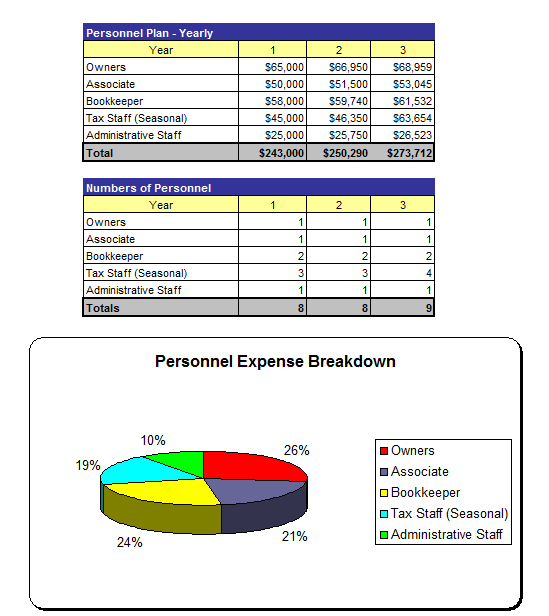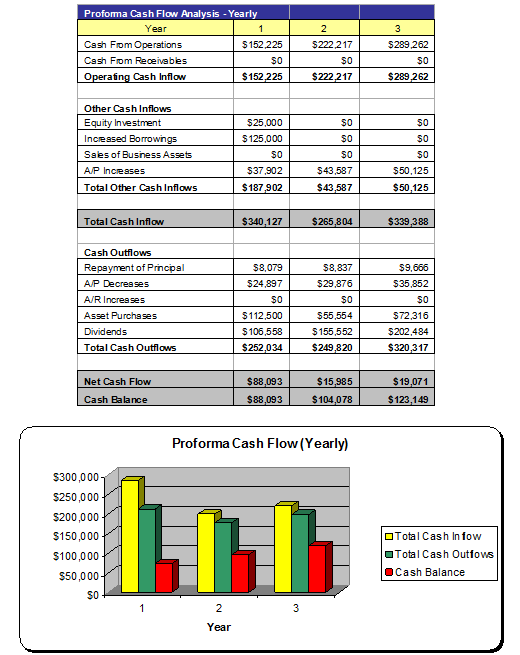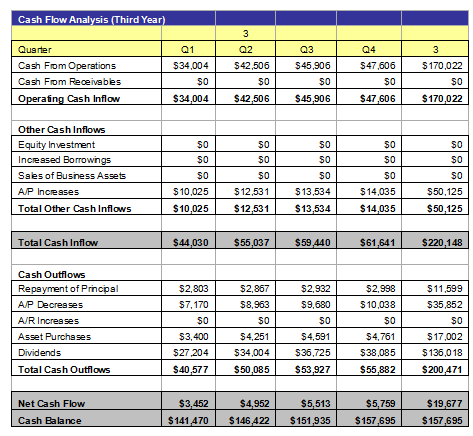Free Winery Business Plan
For Raising Capital from Investors, Banks, or Grant Companies!
Please note that the financials
in this complete free business plan are completely fictitious and may not
match the text of the business plan below. This free business plan demonstration
purposes only. If you are interested in purchasing the completed editable MS Word
and Excel documents for this business plan, please click the button below! Also,
the text of the business plan is formatted with a fully automated
table of contents.
Return to
Samples Page
It should be noted that there is no special software required to use these
templates. All business plans come in Microsoft Word and Microsoft Excel format.
Each business plan features:
- Excecutive Summary
- Company and Financing Summary
- Products and Services Overview
- Strategic Analysis with current research!
- Marketing Plan
- Personnel Plan
- 3 Year Advanced Financial Plan
- Expanded Financial Plan with Monthly Financials
- Loan Amortization and ROI Tools
- FREE PowerPoint Presentation for Banks, Investors,
or Grant Companies!
1.0 Executive Summary
The purpose of this business plan is to raise $5,000,000 for the development of a winery and vineyard while showcasing the expected financials and operations over the next three years. The Winery, Inc. (“the Company”) is a California based corporation that will produce and sell a number of varieties of wines via retail and wholesale distribution channels. The Company was founded in 2009 by John Doe.
1.1 Products and Services
As stated above, the Winery will specialize in providing a number of wine products, which will be distributed on a both a wholesale and retail level. Management expects that 75% of the Company’s revenues will come from wholesale distribution of the Company’s products. The business will produce a number of different vintages including merlots, cabernets, and shiraz style wines. Mr. Doe expects that the business will aggregately generate gross margins of 62% on each dollar of revenue produced. The business will engage a substantial marketing campaign to brand the Company’s products as premium wine products. The third section of the business plan will further describe the services offered by the Winery.
1.2 The Financing
Mr. Doe is seeking to raise $5,000,000 from as an equity investment. The terms, equity covenants, and equity percentages are to be determined at the time of negotiation. Tentatively, Mr. Doe anticipates that the Company will sell a 40% equity interest in the business in exchange for the capital sought in this business plan.
1.3 Mission Statement
The Winery’s mission is to develop, produce, and distribute a number of wines on a nationwide basis while concurrently increasing the visibility of the business as a premier winery. Additionally, Management will always abide by all state and federal laws regarding the production and distribution of alcohol products.
1.4 Mangement Team
The Company was founded by John Doe. Mr. Doe has more than 10 years of experience in the wine producing industry. Through his expertise, he will be able to bring the operations of the business to profitability within its first year of operations.
1.5 Sales Forecasts
Mr. Doe expects a strong rate of growth at the start of operations. Below are the expected financials over the next three years.

1.6 Expansion Plan
The Founder expects that the business will aggressively expand during the first three years of operation. Mr. Doe intends to implement marketing campaigns that will effectively target individuals (and wholesale distributors) that will enjoy the Company’s wine products.
2.0 Company and Financing Summary
2.1 Registered Name and Corporate Structure
Winery, Inc. The Company is registered as a corporation in the State of California.
2.2 Required Funds
At this time, the Winery requires $5,000,000 of equity funds. Below is a breakdown of how these funds will be used:

2.3 Investor Equity
At this time, Mr. Doe is seeking to sell a 40% interest in the Winery in exchange for the capital sought in this business plan. The investor will also receive a seat on the board of directors and a regular stream of dividends starting in the first year of operations.
2.4 Management Equity
John Doe owns 100% of the Winery, Inc. This capital structure will change once the business receives its capital infusion.
2.5 Exit Strategy
If the business is very successful, Mr. Doe may seek to sell the business to a third party for a significant earnings multiple. Most likely, the Company will hire a qualified business broker to sell the business on behalf of the Winery. Based on historical numbers, the business could fetch a sales premium of up to 8 to 10 times earnings.
3.0 Products and Services
Below is a description of the wine products offered by the Company.
3.1 Wholesale Distribution of Wine Products
Prior to the onset of operations, the business will develop a number of relationships with wine distributors throughout the United States. This will ensure that the Company will be able to immediately divest its inventories of wines once the Company begins distribution. Management expects that it will be able to begin distribution of completed products by the end of the 2009 fiscal year. The Winery will feature a number of different grapes that will allow the business to produce a number of different wines including merlots, cabernets, shiraz wines, and blended wines. At all times, the business will remain within the letter of the law regarding the production, distribution, and sale of wine both on a state and federal level.
3.2 Retail Distribution of Wine
The Company’s secondary distribution channel will come from direct sales of wine to customers that visit the Winery. The business will sell wines both by the bottle and by the case directly from its location as well as an online ordering website that will be developed prior to launching the operations of the Winery. The Winery will feature an extensive tasting room and wine store where customers can directly purchase the Company’s products. The Company will employ four zymurgists (wine producing experts) that will provide insightful information about the Company’s products and the wine producing operations of the business.
4.0 Strategic and Market Analysis
4.1 Economic Outlook
This section of the analysis will detail the economic climate, the winery industry, the customer profile, and the competition that the business will face as it progresses through its business operations. Currently, the economic market condition in the United States is in recession. This slowdown in the economy has also greatly impacted real estate sales, which has halted to historical lows. Many economists expect that this recession will continue until mid-2010, at which point the economy will begin a prolonged recovery period. As wine is a luxury product, by most standards, the business may have some issues with top line income at the onset of operations. However, the targeted end user of the Winery’s products will tend to be upper middle income individuals, which are less swayed by deleterious economic conditions.
4.2 Industry Analysis
The sale of wine is a $43 billion dollar industry that provides jobs to more than 100,000 Americans. Within this industry, there are more than 2,000 individual wineries and vineyards that provide more than 22 million bottles to the general public. However, many of these companies deal in small volumes of alcohol sales. This is evident within the United States, where small wineries and vineyards dominate the American market. A significant amount of the wine consumed in America is imported from France, Italy, Australia, and other markets that have climates that are acceptable for grape growth. South American sparking wines have also become prominent members of the market with new blends coming from Chile, Argentina, and Uruguay. The companies within this market all face similar performance and economic issues. The supply and demand curves found within this industry are uniform as they all face the same interest rate, economic, and agricultural issues. One of the primary shifts in the industry over the last ten years is the marketing approach that these companies have collectively used to promote their respective brands. The focus many new and established wines, cognacs, and liquors is to partner with major celebrities. Over the last five years, the celebrity aspect of the media has propagated throughout the world with the advent of the internet and streaming media communications. As such, the interest among the general public concerning celebrity lifestyles has grown significantly, and there are many television shows that are dedicated to showcasing their luxurious lives. Alcoholic beverage companies, apparel businesses, high end automotive manufacturers have all begun to develop co-branding and marketing relationships due to this shift in media attention.
4.3 Customer Profile
In this section of the analysis, you should describe the type of customer you are seeking to acquire. These traits include income size, type of business/occupation; how far away from your business is to your customer, and what the customer is looking for. In this section, you can also put demographic information about your target market including population size, income demographics, level of education, etc.
4.4 Competitive Analysis
This is one of the sections of the business plan that you must write completely on your own. The key to writing a strong competitive analysis is that you do your research on the local competition. Find out who your competitors are by searching online directories and searching in your local Yellow Pages. If there are a number of competitors in the same industry (meaning that it is not feasible to describe each one) then showcase the number of businesses that compete with you, and why your business will provide customers with service/products that are of better quality or less expensive than your competition.
5.0 Marketing Plan
Winery, Inc. intends to maintain an extensive marketing campaign that will ensure maximum visibility for the business in its targeted market. Below is an overview of the marketing strategies and objectives of the Company.
5.1 Marketing Objectives
-
• Develop a relationship with a major marketing firm that will properly brand the Company’s wine products within the market.
-
• Establish relationships with national level wine distributors.
-
• Develop an online presence by developing a website and placing the Company’s name and contact information with online directories.
5.2 Marketing Strategies
The Winery’s products will be marketed with a broad spectrum of sales and marketing strategies that will promote its high-end brand name. This is the crux of the Company’s operations, as wine has become somewhat of a commodity within its economic market. The key to succeeding within the alcoholic beverage industry is to develop a brand and an image associated with the wine product. To that end, Management has developed an extensive marketing campaign that will place the Winery’s products within the same market as Taittinger, Dom Perignon, and other premium alcoholic beverage manufacturers. Second, repetition of product is another very commonly used technique to promote a product. A recently published study indicates that the average consumer must be exposed to a product approximately 100 times before they become familiar with the brand name. As such, the business will engage an extensive print marketing campaign that will focus on high end lifestyle magazines so that the Company’s target audience becomes familiar with the Company’s brand name. In order to develop the Winery’s products as premium products, Mr. Doe intends to hire a national level marketing and advertising firm that will properly implement marketing campaigns and targeted advertisements. Within the first year of operations, Management expects to spend $250,000 to promote the Winery brand. Additional publicity activities designed to generate interest in the Winery’s products will include news articles, lifestyle articles, and product reviews that will further increase the visibility of the Winery brand name. Management intends to use public relations as one of its primary tools for increasing visibility.
5.3 Pricing
In this section, describe the pricing of your services and products. You should provide as much information as possible about your pricing as possible in this section. However, if you have hundreds of items, condense your product list categorically. This section of the business plan should not span more than 1 page.
6.0 Organizational Plan and Personnel Summary
6.1 Corporate Organization

6.2 Organizational Budget

6.3 Management Biographies
In this section of the business plan, you should write a two to four paragraph biography
about your work experience, your education, and your skill set. For each owner or
key employee, you should provide a brief biography in this section.
7.0 Financial Plan
7.1 Underlying Assumptions
-
• The Winery will have an annual revenue growth rate of 16% per year.
-
• Mr. Doe will acquire $5,000,000 of equity funds to launch the operations of the Winery.
-
• Management will settle most short term payables on a monthly basis.
7.2 Sensitivity Analysis
In the event of an economic downturn, the business may have a decline in its revenues. Wine products, by most standards, are considered luxury products. As such, the business may see sluggish sales growth as the US and global economies are currently reeling from a number of serious economic issues. However, the Company generates substantial gross margins from its sales, and this, coupled with the fact that the business is targeting higher income individuals will ensure that the business remains financially stable during the course of its operations.
7.3 Source of Funds

7.4 General Assumptions

7.5 Profit and Loss Statements

7.6 Cash Flow Analysis

7.7 Balance Sheet
 .
.
7.8 General Assumptions

7.9 Business Ratios

Expanded Profit and Loss Statements




Expanded Cash Flow Analysis



